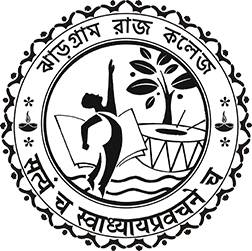
Estd.: 1949
A affiliated College under Vidyasagar University
Recognized by UGC under 2f and 12 B


Govt. Of West Bengal
 |
JHARGRAM RAJ COLLEGE Estd.: 1949 A affiliated College under Vidyasagar University Recognized by UGC under 2f and 12 B |
 |
 Govt. Of West Bengal |
Pabitra Kumar Sen Memorial Forum for Community Work
Jhargram: A Land of Tribes The newly formed district, Jhargram was part of West Midnapore district till 2017. Jhargram is part of the area known as Jangalmahal, designated by British. The primitive residents or Adivasis or the sons of the soil living in Jhargram subdivision and surrounding areas are mainly tribal communities of three types: Lodha, Sabar and Santal, each of them is culturally different from one another. Lodhas derive sustenance and nourishment from the Jungle by cutting and collecting woods, while the Sabar prefers their living by hunting animals. The Santals depend mainly on agriculture. All the tribes had a rich culture of various activities: puja, parbon, rituals, songs and dances: Chuang, Chang, Chou,Dangrey, Jhumur, Panta, Ranpa, Saharul, Tusu, Bhadu and so on. Apart from popular Bengali festivals like Durga puja, Holi, Rath Jatra, Kali Puja, Saraswati puja- these tribes mainly focus on Pujas related to woods and trees in form of ‘Ed’ Puja and ‘Karam Puja’. They worship the roots of trees, which is locally known as “Than” and offer their certain ritual rites. However, with the advent of modernization things are changing and the local culture seems to lose its originality and some are even at the verge of extinction. Jhargram Raj College: A Centre of Studies for both Tribes & General Categories Jhargram Raj College, situated at the heart of the district Jhargram, established in the year 1949 by the Rajas of Jhargram. Though initially started as an Agricultural College, it took the status of Degree College enlightening a large group of learners in various disciplines. Along with general categories, students coming from these tribes of local areas are also part of our student fraternity. A certain percentage of total seats of the students are reserved for ST categories as per admission guide lines. The College is therefore a forum where the adivasi(tribal) culture is being assimilated with other culture as both students and teachers from other culture and district are also part of the teacher- student community. Incollege’s cultural programmes, students coming from such tribal communities perform and entertain others with their Pata (leaf)dance or other local songs and in return are influenced by the urban culture. Urge to Preserve the Local Culture and Formation of Pabitra Kumar Sen Memorial Forum for Community Work The College Forum felt an urge to know the local culture in detail and showed an interest to preserve it as most of the culture and practises by the sons of soil are getting extinct with the death of the older generation. The new generation is failing to retain their uniqueness. Even the local languages like Santali, Mundari, Kudmali are spoken by very few people coming from these community. Occasionally in programmes or any events they recite a poem or sing a song in these languages. Jhargram Raj College opened a Forum under the name of “Pabitra Kumar Sen Memorial Forum for Community Work” to perform some outreach activities by students, teachers and non- teaching staff of the college to understand the local culture. In various academic session students, guided by some teachers visit different villages with an intension to know about the locals and localities surrounding the college. Although the practice of visiting the villages and enquiring their life style along with helping them with some gifts or teaching small students was already in vogue, the forum was formally formed under the present name after the workshop on “Career Prospects in Mass Communication and Journalism”. Understanding that there is different nature of ‘communication’ as well as various sort of ‘mass’, students felt an urge
Visit to Baguashol village A group of students from UG final year (Arts faculty) visited the Mahali village , Baguashol, near Kulti Kiri. They interviewed the local people and tried to know their ways of earning by making caps and utensils made of cane (a material extracted from bamboo trees) Visit to Khoab Gna (Village) Students mainly from English Department (second year) showed interest to visit the local tribal families and in return teach the young children of these families English alphabets, words and numbers. The art of painting and different crafts like eco-printing are also guided by the students. The local culture of making some items from the roots of the trees is in return what we get to know from them. During the time of Tusu festival they make Tusu idols out of clay and decorate them. Formation of “Pabitra Kumar Sen Memorial Forum for Community Work” 2019-2020 Visit to villageRajpara, P.O – Pukuria P.S- Jhargram on 9.2.2020. A group of students and teachers went to Rajpara village, near Pukuria, Jhargram and interacted with the Santal Community. Set of questionnaires were given to them for querying the changing pattern in Santal community. The students gifted the young one’s candies and colour books and colour pencil boxes to befriend them. Students giving the young ones some education kits and interviewing the Strikingly most of the young ones are going to local schools and are getting formal education. Students enquired their culture and festivals and came to know that during Dol Purnima ( Holi) , they perform Baha Puja to celebrate the falling of old leaves and and coming of new leanes to celebrate death and new beginning. They drench each other in water (plain water and not colour water). They offer ritual rites in the roots of the trees and make clay ovens to offer food ( Bhog) to Goddess and to the villagers. They also perform Sohrai festival, which is similar to Nabanna Utsab, celebrating the rice- harvest. In this festival cows are worshipped. During Durga puja, they celebrate Dasai, to commemoratethe death of Mahisasur. This tribal community believes that mahisasur is one, among them and is their God, whom Durga has killed unlawfully. They consider Durga a villain and a prostitute as she has been empowered by different male Gods. The little ones performed a dance in front of us and showed their local place of worship.
Interviewing the different generation of Santal Community it became evident that the young generation is speaking fluently in Bengali language. Their schooling is also in Bengali medium. They are not supporting Santali medium school. They think that if Government promotes Santali schools, it may cause hindrance as their formal education have been in Bengali and not many books of higher studies are written in Santali languages. Though these families communicate and converse among them in their own local languages, the older generation knows their own language more than the young generation. Visit to village Antapati, near Khanakul, Jhargram To identify the nature of Tribal Communication, group of students followed by teachers and non –teaching staff Srimani Saren went to village Antapati, near Khanakul, Jhargram. Srimani Saren acted almost as a “ dobhasi” to communicate with the tribal family and make the students understand their words. Initially shy and embarrassed to talk, they were quickly befriended by the students who offered them sweets and writing pads and pens. The students got an idea about their local life style, rituals, their ways of dressing and so on. Most of the houses and areas surrounding the houses are clean, have separate bathrooms, but they all seem to have open kitchen – ovens are made of clay and utensils are mainly earthen pots. The students advised them to keep separate bins for plastics and wet wastes. Interviewing the tribal families, the students summed up that the tribal communities have different sort of communication methods:
Outcome of the Community work The outreach activities done by the college students, teachers and non-teaching staff of the College have deep impact on the surveyors as well as the people whom we survey. As responsible citizens, the college has some duties towards society. Local people can feel that the college is part of the society and does not stand isolated with some teachers and students coming from urban localities. Though initially shy and embarrassed, the local people gradually communicated enthusiastically with us. A two-way impact is noticeable, the surveyors get a wide knowledge and understanding of the local culture, ritual and ways of communication and in return they encourage the local communities to retain their culture and practises. College through the student surveyors are offering a helping hand to these communities.
Visit to village Rajpara with students, teachers and non-teaching staff of Physiology department on the eve of science day, health check-up and nutritional counselling of children belonging age 05 years to 12 years. |
Reach us: |